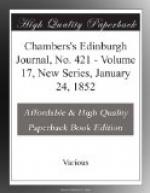One feature with which a stranger cannot fail to be struck on his arrival in the island, and which is essentially tropical, is the abundance of the lizards that everywhere meet his eye. As soon as ever he sets foot on the beach, the rustlings among the dry leaves, and the dartings hither and thither among the spiny bushes that fringe the shore, arrest his attention; and he sees on every hand the beautifully coloured and meek-faced ground-lizard (Ameiva dorsalis), scratching like a bird among the sand, or peering at him from beneath the shadow of a great leaf, or creeping stealthily along with its chin and belly upon the earth, or shooting over the turf with such a rapidity that it seems to fly rather than run. By the road-sides, and in the open pastures, and in the provision-grounds of the negroes, still he sees this elegant and agile lizard; and his prejudices against the reptile races must be inveterate indeed if he can behold its gentle countenance, and timid but bright eyes, its chaste but beautiful hues, its graceful form and action, and its bird-like motions, with any other feeling than admiration.
As he walks along the roads and lanes that divide the properties, he will perceive at every turn the smooth and trim little figure of the wood-slaves (Mabouya agilis) basking on the loose stones of the dry walls; their glossy, fish-like scales glistening in the sun with metallic brilliancy. They lie as still as if asleep; but on the intruder’s approach, they are ready in a moment to dart into the crevices of the stones and disappear until the danger is past.
If he looks into the outbuildings of the estates, the mill-house, or the boiling-house, or the cattle-sheds, a singular croaking sound above his head causes him to look up; and then he sees clinging to the rafters, or crawling sluggishly along with the back downward, three or four lizards, of form, colour, and action very diverse from those he has seen before. It is the gecko or croaking lizard (Thecodactylus loevis), a nocturnal animal in its chief activity, but always to be seen in these places or in hollow trees even by day. Its appearance is repulsive, I allow, but its reputation for venom is libellous and groundless.
The stranger walks into the dwelling-house: lizards, lizards, still meet his eye. The little anoles (A. iodurus, A. opalinus, &c.) are chasing each other in and out between the jalousies, now stopping to protrude from the throat a broad disk of brilliant colour, crimson or orange, like the petal of a flower, then withdrawing it, and again displaying it in coquettish play. Then one leaps a yard or two through the air, and alights on the back of his playfellow; and both struggle and twist about in unimaginable contortions. Another is running up and down on the plastered wall, catching the ants as they roam in black lines over its whited surface; and another leaps from the top of some piece of furniture upon the back of the visitor’s




